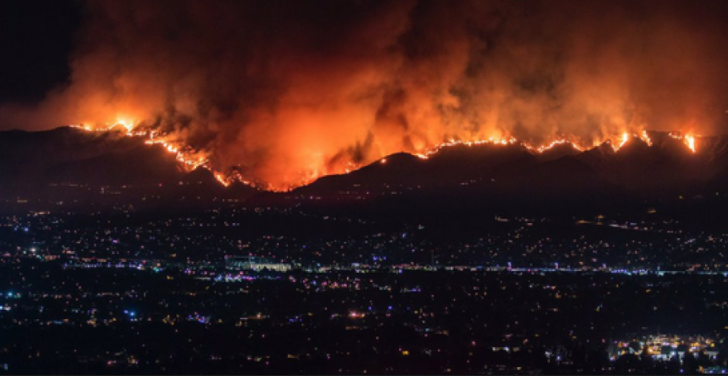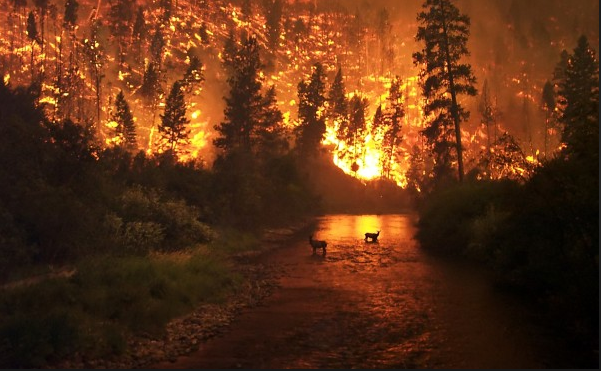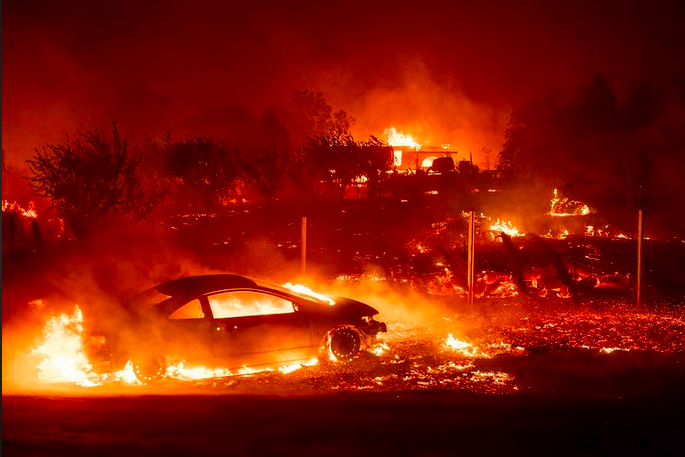Think You’re Safe from Climate Impacts?
Think again.
If you do not live by an ocean or sea or major river, or if you live on high ground, then you might expect to escape climate impacts from rising seas or flooding. If you avoid living near a forest or woodlands, then you might expect to escape climate impacts from extreme fires. If you do not live in an area subject to hurricanes, tornadoes or other extreme weather events, then you might expect to avoid climate impacts from these events.
If you do live in a vulnerable area, then you might be able to move, if you’re rich and lucky enough.
All well and good for avoiding direct impacts from climate breakdown. But then there are those pesky indirect impacts. For instance, if you live in California it is increasingly likely that you’ll lose your power for stretches of time even if you live far away from areas at risk of fires.
How is that possible?
One of the California utilities, Pacific Gas & Electric (PG&E), provides electricity to about 16 million people across the state. Under California law, utilities are legally liable for damages that result from fires caused by the negligence of the utility. Wide-spread and deadly fires over the past few years were started by sparks from power line, and PG&E has been found negligent for failing to maintain those wires and liable for damages, likely exceeding tens of billions of dollars. The scope of liability is so large that PG&E declared bankruptcy in January 2019. The state and utility are trying to figure out how to protect people from injuries and properties from being destroyed by fires, and to make sure that everybody has sufficient power at affordable prices.

The fires were started by sparks from power lines but the fires were spread and intensified by weather conditions, namely dry conditions for months which dried out vegetation, brush, and forests, as well as strong winds. These extreme weather events are, of course, getting more frequent and stronger as a result of climate breakdown.
After another dry summer and the potential for strong winds developing again this fall, several weeks ago the utility shut down part of the power system serving over 800,000 people. The areas affected include Silicon Valley, which brought the world untold electric gadgets, including iPhones and MacBooks, and which was without power. The power was turned back on after several days, but over the past week, and continuing, power was shut down again because of the risks from weather.
Some of the almost 1 million people would have the resources to buy gas-fueled generators for their own use, but even those became scarce and expensive and have limited power. A few have even hired private companies to extinguish fires on their property. Most people do not have such resources, and had to endure the consequences of the power outage, including no air conditioning.
Recent news report that even LeBron James, the basketball star, and Arnold Schwarzenegger have had to flee their homes.

As one Californian noted, “You don’t expect power to go out”… “But welcome to the Third World country that is America.”
So one can expect such indirect impacts from climate breakdown to proliferate. And they won’t be confined to the west coast.
On the east coast, a number of years ago, Super Storm Sandy knocked out the infrastructure in New York City, including power substations and subways that affected millions for days and weeks. Some of the subway systems are still undergoing repairs and disruptions at this moment.

It is going to become increasingly harder to avoid the serious to catastrophic impacts from climate breakdown, regardless of where you live. A recent report by the U.S. Army War College on the implications of climate change ominously reported:
“The power grid that serves the United States is aging and continues to operate without a coordinated and significant infrastructure investment. Vulnerabilities exist to electricity-generating power plants, electric transmission infrastructure and distribution system components,” it states. As a result, the “increased energy requirements” triggered by new weather patterns like extended periods of heat, drought, and cold could eventually overwhelm “an already fragile system.” See Ahmed below.
As Abrahm Lustgarten notes, “It is easy to ignore climate change in the bosom of the developed world,” but it hits home when your own lights go out in the world’s fifth-largest economy.
Sources
Alejandra Borunda, “How climate change primed California’s power shutdown,” National Geographic (10 Oct 2019). on.natgeo.com/2p7Vhm7
Alejandra Borunda, “Are Europe’s Historic Fires Caused By Climate Change?” National Geographic (31 July 2018). on.natgeo.com/2vEBZUX
Phil Willon, Joe Mozingo, Rong-Gong Lin II and Maura Dolan, Los Angeles Times, “California enters uncharted territory: Massive blackouts, historically dangerous wind,” Microsoft News (25 Oct 2019). bit.ly/36hKh6W
Nafeez Ahmed, “U.S. Military Could Collapse Within 20 Years Due to Climate Change, Report Commissioned By Pentagon Says,” Vice (24 Oct 2019). bit.ly/2pW57ry
United States Army War College, Implications of Climate Change for the U.S. Army bit.ly/31OjbRl
Abrahm Lustgarten, “Mandaory Blackouts,” The New York Times Sunday Magazine, at 22 (27 Oct 2019).


No comments yet, add your own below